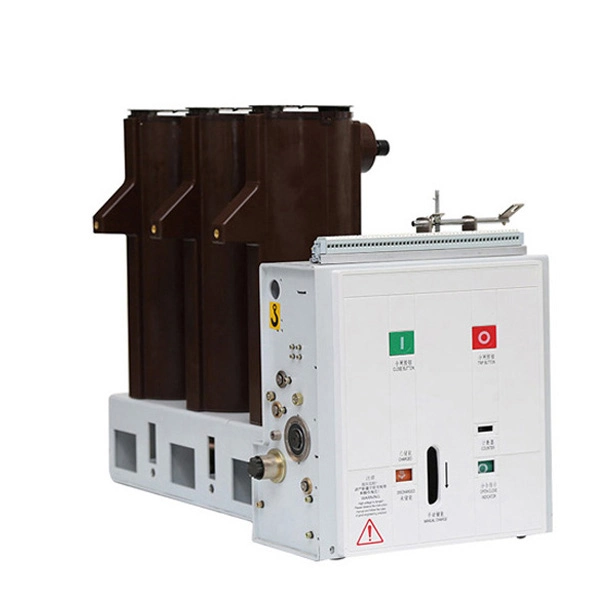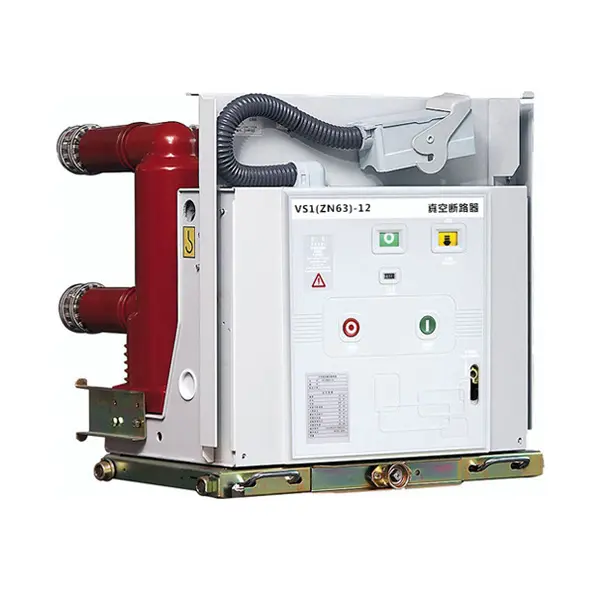真空遮断器
Vacuum circuit breaker is a kind of switching equipment specialized in electric power system, which can quickly cut off the current when the circuit is faulty, so as to protect the circuit and related equipment. In this article, we will discuss in detail the working principle, design characteristics of vacuum circuit breaker and its importance in modern power system.
What is a vacuum circuit breaker?
Vacuum circuit breaker, referred to as a circuit breaker with a vacuum interrupter, which operates in a vacuum medium to achieve efficient current cut-off and turn-on. This design allows vacuum circuit breakers to have superior insulation and arc extinguishing capabilities when faced with high voltages.
Principle of operation of vacuum circuit breakers
The main principle of vacuum circuit breakers is to eliminate arc energy in the contacts (moving and static). When circuit breaker contacts are opened in a vacuum, an arc is created between the contacts. However, because ions and metal vapors condense quickly on the contact surfaces, the arc can be extinguished quickly, thereby enhancing the strength of the dielectric. This characteristic makes vacuum circuit breakers ideally suited for high-voltage power equipment systems.
Characteristics of vacuum circuit breakers
The insulating dielectric of vacuum circuit breakers exhibits excellent arc extinguishing capability, comparable to that of air and SF6 circuit breakers. The contacts operate in a vacuum environment and are capable of breaking the initial current below zero, significantly increasing the strength of the dielectric. This design makes vacuum circuit breakers efficient, lightweight and cost effective, while not requiring expensive maintenance.
Nature of Vacuum Circuit Breakers
The contact opening distance is small. The opening distance of vacuum circuit breaker contact is small. For example, a 10kV circuit breaker only needs an opening distance of about 10mm, with small operating power and a long mechanical life.
Arc burning time is short: the arc burning time of a vacuum circuit breaker is very short, usually about half a week wave-about 10ms; it is irrelevant to the size of the current.
This is further enhanced by the better dielectric characteristics of the vacuum, which make it suitable for the disconnection of faults in the vicinity.
Longer operation time: since the wear and tear at the time of the contact engagement is too small, the electrical life of a vacuum circuit breaker is long. With this device, 30 to 50 full-capacity openings can be carried out and the rated current achieved may be 5000 cycles or more.
In the case of vacuum circuit breakers, size and weight are less compared to conventional circuit breakers; hence, installation and maintenance become easy.
Compatible with capacitive load: able to switch off current of capacitive load; compatible with the application of high voltage power grid.
Type of vacuum circuit breaker
A typical model designation for a vacuum circuit breaker includes several letters followed by a number, the combination of which defines the design and performance characteristics. Some specific interpretations follow:
Product code: to represent letters for different types of circuit breakers, “Z” for vacuum circuit breaker, others are “S” – oil less circuit breaker, “K” – air circuit breaker, “L” – sulfur hexafluoride circuit breaker, and so on.
Installation location code: “N” means indoor installation and “W” means outdoor installation.
Design Series No.: 1, 2, 3, etc., are some numbers indicating a series of designs.
Rated voltage kV, meaning the rated voltage grade of the circuit breaker could be 10kV or 12kV.
Rated current in A: Value of the current the breaker can safely carry, ex: 630A, 1250A, etc.
Rated breaking current: maximum value of current which a circuit breaker is capable of breaking under condition of short-circuit, e.g., 20kA, 25kA etc.
For example, the meaning of ZN12-10 type vacuum circuit breaker is
“Z” for vacuum circuit breaker
“N” = Installation indoor
“12” represents design series No.
“10” indicates that the rated voltage is 10kV.
Vacuum Circuit Breaker Applications
Vacuum circuit breakers are used in power systems where the voltage range is between 11kV and 33kV. During their operation, the contacts are completely sealed in a vacuum cylinder, ensuring that they are separated without arc generation. Advantages offered by this design include low maintenance requirements, no gas emissions, long service life and low noise levels, making it ideal for indoor environments.
Selection technique in vacuum circuit breaker
Selection of proper vacuum circuit breaker shall be based on the following:
Selection is done according to the switchgear type:
In indoor fixed switchgear, such as 10kV switchgear, this type of ZN28 breaker is the most applicable, having properties for electrical and manual operations via a spring mechanism.
In indoor switchgear of the move-open type, such as KYN type with a spring-integrated operating mechanism, the VS1 type circuit breaker can be chosen.
Rated current Selection: Normal rated current will be 630A, 1000A, 1250A, 1600A, etc. It has to be selected with accordance to the calculation by load current.
For instance, a 2000kVA transformer rated current of 115.5A would select 630A circuit breaker as:.
Calibration of the breaking current The rated breaking current of the circuit breaker shall be higher than the peak value of the short-circuit current at the place of installation.
For instance, when the maximum short circuit current is 26kA; the following specification can be selected: the circuit breaker whose opening current is 31.5kA.
Other calibration variables are a relative spacing of the phases, installation-dependent parameters, interlocking conditions, presence of an overcurrent coil or loss-of-voltage coil among others for system compatibility.
Principle of operation of high voltage vacuum circuit breakers
High-voltage vacuum circuit breakers are switchgear designed for high-voltage power systems, utilizing vacuum as the insulation and arc-extinguishing medium, and are characterized by small size, light weight, and simple maintenance.
Components of vacuum circuit breakers
Important components of a vacuum circuit breaker include tie rods, flexible connections, terminals, vacuum indicators, operating levers, locking cams and breaker springs.
The main components of a vacuum circuit breaker include:
Vacuum bottle: the core component, used for isolation and arc quenching, usually made of ceramic or glass material, able to withstand high temperature and high pressure.
Contacts: the main electrical connection parts, usually made of copper material, with good electrical conductivity and wear resistance.
Fixed contacts: fixed contacts located in the body of the vacuum bottle to ensure the stability and safety of the circuit.
Spring: the main source of force used to push the separation of the vacuum bottle and the movable contact.
Operating lever: the device controlling the switching state of the vacuum circuit breaker, which can be driven by hand or electric motor.
Conductive rod: the electrical component that connects the external power supply to the internal contacts of the vacuum circuit breaker.
Release mechanism: Mechanism that ensures quick opening of the vacuum circuit breaker under abnormal conditions.
Vacuum interrupter: the core component, the internal high vacuum environment.
Operating mechanism: control the opening and closing of the circuit breaker.
Insulation support parts: support the parts and provide insulation.
Conductive connectors: connect the various parts of the circuit.
Shell: protects the internal components from the external environment.
Operating Mechanism
The vacuum interrupter chamber is normally maintained in a high vacuum below 10^-4 Pa, an environment that effectively prevents the flow of current. When the circuit needs to be disconnected, the movable and static contacts separate quickly, and the arc is extinguished rapidly due to the lack of gas support, thus completing the disconnection.
The operating mechanism is responsible for opening and closing the circuit breaker, and usually contains a spring-loaded energy storage device that actuates the contacts to separate by releasing the stored energy. The mechanism can be controlled manually or remotely.
Maintenance and Applications
Maintenance of high-voltage vacuum circuit breakers is relatively simple and consists mainly of regular inspections of appearance, vacuum and contact wear. They are widely used in substations, industrial power distribution and urban grids to ensure the safe and reliable operation of high-voltage power systems.
結論
High-voltage vacuum circuit breakers are widely used in high-voltage power systems for their high reliability, long life and simple maintenance. In the future, with the progress of science and technology and the development of smart grid, vacuum circuit breakers will play an increasingly important role in efficient energy management and sustainable development.


